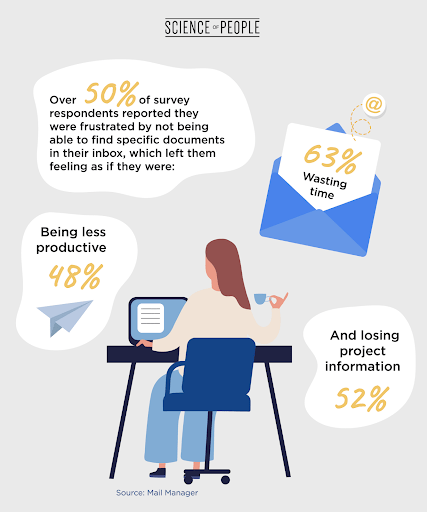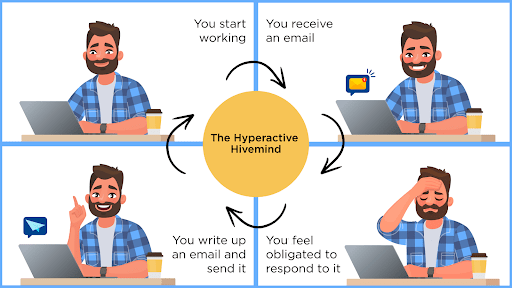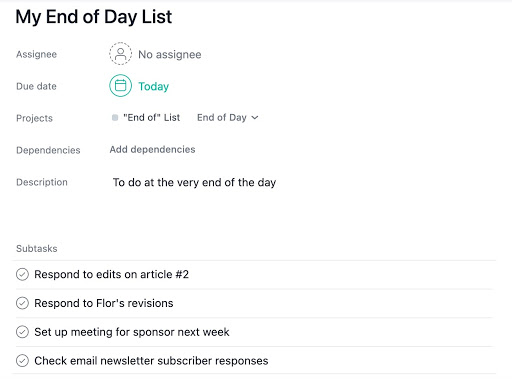Did you know that the average office worker receives 121 emails per day?
And that most of us are checking our email at work every 6 minutes?
Information overload is real. And it needs to stop.
I sat down with Cal Newport. Cal is a computer science professor at Georgetown University and the best-selling author of 7 books! His newest book, A World Without Email, tackles the essential question: How do we improve the workplace so that important communications don’t use email?
Check out our video below:
Our goal is to help you step up your email productivity game. In this guide, you will learn:
- how to avoid information overload
- why email is the #1 killer of productivity
- why you’re so addicted to checking emails
- how to manage emails (and your time) like a boss
Can’t I Just Batch My Emails?
Let me guess—you’ve been told to “batch” your emails.
While that may work for some, there’s a big catch. In a groundbreaking study, researchers from the University of California conducted an experiment:
- They hooked up 40 office workers to heart rate monitors for 12 days.
- They found that the longer one spends on email in a given hour, the higher their stress (not surprising).
- They also found that the higher one’s personality trait of neuroticism, the higher their stress levels when they batch emails (more surprising).
So for some people, batching emails can actually cause more harm than good, especially if they tend to get stressed easily. So how do we solve this problem? What’s the better alternative to checking emails?
Why Email Ruins Productivity
Are you constantly checking your emails every day? This could be bad, according to a 2021 survey by Mail Manager.

The survey, conducted on 500 business leaders, found that more than half reported they were frustrated by not being able to find specific documents in their inbox, which left them feeling as if they were:
- wasting time (63%)
- being less productive (48%)
- losing project information (52%)
Yikes! Not to mention constantly checking email can totally break our concentration (more on that later).
Which leads me to the big question…
Why do we work this way? Why do we allow email to replace other forms of deeper conversation? Why do we have notifications turned on all the time? Why can’t we get the important work done first, then check email later?
The Reason Why You’re Always Checking Email
To understand why we use so much email, let’s take a look at the history of email (it’s truly fascinating!).
Email started growing in the early 1990s. As people found out that emails were generally cheaper, faster, and more efficient than fax machines, email users exploded in growth, from 55 million users worldwide in 1997 to 400 million by 1999.
And here’s where the email-communication problem starts…
With the rapid growth of email, emails started replacing all the ways we used to communicate. We suddenly started having:
- fewer meetings
- fewer phone calls
- fewer real, in-person conversations
This isolated people and inhibited work efficiency—email doesn’t scale.
This means we sacrificed real, sporadic in-person communication with multiple back-and-forth emails with clients and managers—emails that take a whole lot of time, and with only one person (ourself) to answer them. We all know how long email chains can get, so we rush to reply to emails so we don’t delay the process even further.
This is where the concept of the “hyperactive hivemind” comes in.
What is the hyperactive hivemind?
Cal Newport describes the hyperactive hivemind as “a workflow centered on ongoing conversation fueled by unstructured and unscheduled messages.” In the hivemind, people tend to keep their communication lines open by responding to emails, phone calls, or Zoom calls throughout the day. The hyperactive hivemind can be detrimental to deep work.
The Hyperactive Hivemind ruins our workflow since we’re constantly on alert.

It’s not irrational. It’s not about being bad with our communication tools. It’s not our fault.
Here’s the big problem: We’re not computer processors. We can’t just execute processes one after the other—we need time to switch our attention from one thing to another.
When we always have our communication lines open, our precious mental resources get taken away, distracting us from the critical deep work we need to get stuff done.
The hyperactive hivemind is productivity poison.
The Real Danger: Information Overload
With the constant stream of messages and information, we’re subject to one deadly problem: information overload. According to a study by the Pew Research Center, 20% of people say they feel overwhelmed with information.
What is information overload?
Information overload, also known as information anxiety or “infoxication”, is when we’re exposed to too much information than we can handle at one time. Information overload commonly occurs when we absorb an abundance of information (i.e., through email), often leading us to make illogical decisions or delaying our decisions even further.
When we get overloaded, our brains simply can’t process all the information coming in. And there are many reasons why we get overloaded. Can you relate to any of these?
- You receive countless emails from your coworkers, managers, and boss throughout the day.
- You face pressure to constantly churn out great content, causing you to have a “more is better” mindset.
- You’re bombarded with conflicting information (The task should be assigned here! No, it should be assigned there!).
- You’re constantly juggling around multiple tasks assigned to you.
- You feel stressed when you can’t process information as fast as it arrives.
If that sounds like you, here are some simple tips you can implement right away to combat information overload:
5 Ways You Can Combat Information Overload
Typically, when people have a problem, there’s a go-to answer:
- Want to lose weight? Eat less and exercise.
- Want to get better sleep? Don’t stare at your screen before bed and do something relaxing.
But what about information overload?
We can’t just turn off our computer and phones—especially if our work is online.
While the solution may not be simple, there ARE things I’ve tried that help greatly with information overload:
- Thoughtstorm. If you’re bogged down and stressed out, getting out your ideas onto paper REALLY helps. Grab a pen and paper and let’s get to brainstorming—list out EVERYTHING that’s stressing you out right now. The 20 emails you received from your boss. The manager who told you to fix the printer. That huge 30-page document you had to sift through this morning. Thoughtstorming is like channeling your stress and worries onto paper. When you’ve got everything listed, you’ll be able to focus more on the task at hand instead of worrying about the rest.
- Use your team. If you’re part of a team, don’t shoulder the responsibility yourself. Let’s say you have a manager who constantly sends you tasks to do—why not share them with someone on your team? If they have the bandwidth, both of you could tackle the problem instead of relying on yourself (and two brains are definitely better than one).
- De-internet. Read a book. Go for a walk. Do some yoga. Information usually gets us when we’re on the internet—after all, on the internet, we can hear EVERYONE’S voice. In the real world, not everyone needs to be heard (by us, at least). Go somewhere quiet and detox. I find that a nice walk or short hike keeps me rejuvenated.
- Avoid multitasking. Studies show that multitasking actually makes people less productive than if they stick to one task. Why? Our brains have a hard time “switching” from one task to another. We work our best when we can focus single-handedly on a task without distractions. So consider timeboxing or find a way to work without distractions.
- “Hands-off” management. Are you a micromanager? If you take it too far, you could be hurting others. Most employees like a sense of autonomy—after all, they’re the ones working closely with the project. Try a “hands-off” approach where you take the lead but let them make decisions for themselves. Not only will they appreciate it but they’ll probably know what’s best for the team too!
How to Avoid Information Overload & Manage Your Work Emails in 7 Steps
Alright, let’s focus mainly on the big problem: emails.
It’s not easy getting away from those emails, but you don’t have to scrap them entirely either.
I want you to stop being a victim of communication overload. Follow these 7 steps for maximum email management:
Step 1: Write down your processes
Every time you receive an email, ask yourself this golden question:
“What is the underlying process this email is trying to push forward?”
The email could be dealing with clients, pushing forward a video for production, gathering new pieces of content for the blog, etc. If the email is important, the email sender is relying on your response so they can move on to the next steps.
The key here is actually taking time to write the answer down on a piece of paper or make a note. Some emails you may realize have no significant purpose, such as chitchat emails or long-winded complaints.
Another way to think about this is to make a list or a spreadsheet of every theme or project that hits your inbox. So when I made this list, I noticed that I had themes:
- blog articles – 17 emails
- YouTube videos – 12 emails
- speaking engagements – 8 emails
- scheduling – 24 emails
This was helpful because it let me think about setting up systems in these buckets.
Once you can visually see how your emails are linked, move on to the next step.
Step 2: Look for the one thing
Now comes the interesting part:
What’s the one thing you can do to make your processes easier?
Aim for the low-hanging fruit here—the one simple change that’ll save you the most time.
It can be as simple as using a tool like Calendly to set up frequent meetings with a client instead of doing back-and-forth emails. Or you might realize you can save a lot of time by creating email templates for those repetitive weekly emails.
Once you’ve got one low-hanging fruit, add on a couple more.
This step is crucial because it tells your mind there’s more to communication than just email.
Once you’ve found your one thing and lifted that heavy stress of constant emails off your shoulders, you’ll start to get the momentum going to take control of your time again.
When I saw my batches, I realized we had to create an Asana system that linked together our blog and YouTube video system.
Step 3: Write your “end of” list
My team and I use Asana as our go-to project management tool. And like any good project management software, a great benefit is helping cut down on emails.
One super useful trick we’ve implemented recently is using an “end of day/end of week” list. This list is a task we create in Asana that basically says:
“Hey, Vanessa! When you have time at the end of the day/week, could you please look over X, Y, and Z?”

This process saves us SO much back-and-forth because we’ve given each other plenty of time to get our deep work done during the day while saving communication for later.
Step 4: Implement sprints
A team sprint is hyperfocusing on one project or task to get it done. This usually involves most or all of your important team members needed to get the task done.
Sprints are common in software development teams, where real-time collaboration is important to keep on track so that task dependencies are being met.
However, in most other organizations, the team sprint is lost.
I recommend getting back to the sprint.
Focus all your team’s attention on one task, ignoring emails until that task is complete. That way, the entire team knows what everyone’s working on, and deep work can be completed in the process.
You can even schedule in sprint “days” or “mornings” when your team works on one task during a specific time and a different task the next. I found this helps a TON to avoid those nasty email chains.
Step 5: De-Inbox
Think of your team’s most important day-to-day online resources:
- the project management calendar
- online document writing
- writing tools
Do these resources need to be in the inbox? My answer is no (and I’m sure 99% of companies can scrap the inbox and stay productive too). So if you’re constantly eyeing the inbox to access your team’s resources, the key here is to make your resources available outside the inbox:
- Use a collaborative document to leave comments on.
- Make a resource template with the relevant links in your project management software.
- Set communication software to be outside email, and set notifications outside of deep-work time.
Step 6: Meetings over emails
Instead of sending email after email, try scheduling in one or two weekly meetings where you cover important topics (and save a ton of time from emails in the process).
Email is great for broadcasting, but it’s terrible for interacting.
The general rule of thumb is: If you have to make a big decision or have an important conversation over email, it’s better to have a meeting instead. Emails can be a great reminder to ping people about an upcoming meeting, but save the meat and potatoes for the meeting.
Step 7: Go on an email diet
Just like a gluten-free diet, my team and I have been slowly going on an email diet too.
And just like all diets, it’s OK to start slow and steady to ease into the new system. I get it—email seems like the necessary go-to for all modern companies.
But the key here is not stopping email or communication altogether—it’s about replacing these underlying workflows.
The better your team is able to replace emails, the less you’ll miss using emails in the first place.
Bonus Step #8: Avoid Rope-Chatting
Rope-chatting is a term used to describe when someone greets another team member with an innocent “Hi” in an attempt to rope them into a conversation they may not have time for.
Avoid this—instead, directly ask a question up-front:
- “Hey, can you please send me notes for the last team call?”
- “Hi, do you have any updates on the project?”
- “How are you? Please send over the document when you have time.”
If you need to schedule a chat, provide context and wiggle room to schedule a call. Thanks to Reddit user RockleyBob for this tip!
Dear Reader…
I hope you found this article helpful! I want to help you take control of your time and end all unnecessary distractions in your life.
And for further reading, check out these awesome blog posts:
- 17 Professional Email Tips to Craft Your Next Email (With Templates!)
- How to Do a Digital Detox: 3 Easy Steps for Success
- Be Happy at Work: 10 Science Backed Ways You Can Be Happier
To your success,
Vanessa
